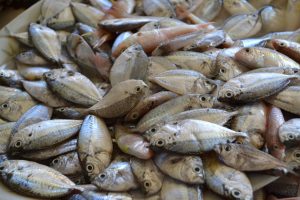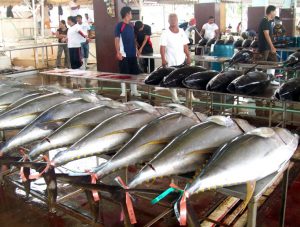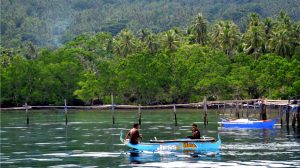Unless Filipinos help protect and manage their coastal ecosystem, the country may don’t have fish to feed its growing population. Already, the resources that provide the “poor man’s source of protein” are already strained to the limits.
“Like the other vital resources such as forests, Philippine fisheries are about to collapse – a victim of the almost unabated plunder of the commons,” deplores Roy C. Alimoane, the director of the Davao-based Mindanao Baptist Rural Life Center (MBRLC).
As defined, the “commons” encompasses unoccupied land and all waters which are considered God-given set of resources for all people to consume as much as needed. In Genesis 1:29, God said: “They will be yours for food.”
But what God had given appear to have been abused to the point of exhaustion. Despite the country’s vast marine resources – 220 million hectares of coastal and oceanic territorial water area – the Philippines is now a shortfall in fish supply.
Fish is a staple food of Filipinos. “Fish and seafood represent an important source of protein for the average Filipino, at around 41%of animal protein intake,” reports the Kuala Lumpur-based World Fish Center.
In 2008, the Philippines ranked sixth in global fish and aquaculture production. Twenty-three years earlier, in 1985, the country was listed number four. Next to China, the Philippines was the second largest seaweed producer in the world.
Five years later, the country ranked seventh worldwide in terms of fish production, according to Bureau of Fishery and Aquatic Resources (BFAR). In 2014, it produced 4.69 million metric tons of fish valued at P237.71 billion.
“These figures suggest we are rich in fisheries and coastal resources as a nation,” said Senator Loren Legarda in a speech.
 Fish shortage
Fish shortage
During his time, French novelist Jules Verne (the man behind “Twenty Thousand Leagues Under the Sea”) suggested that when the world reached the limits of food production on the land, man could turn to the oceans. That was what most countries had been doing over the past several decades.
“Between 1950 and 1989, the fish catch expanded more than four-fold, climbing from 22 million tons to 100 million tons,” Lester R. Brown reported in his feature, “Facing Food Scarcity.” “During the six years since then, the catch has leveled off. Contrary to the prognosis of Jules Verne, we reached the limits of the oceans first.”
This is true particularly in the Philippines, a country with more than 7,000 islands. “A major fishing ground, Lingayen Gulf, reached its maximum sustainable yield more than 20 years ago,” claims a report released by UN Food and Agriculture Organization (FAO). “The fishery now has four times the optimum effort for the available fish stocks. Catch rates in the gulf are only one-fifth of what they were 15 years ago, compelling fishers to invest more time and money in dwindling catches.”
In some areas, not only has the volume of catch been reduced, but also quality. The FAO report cites Central Visayas as a case in point. “There has been an overall shift in catch composition, away from coastal pelagic to oceanic pelagic species and away from demersal to pelagic species,” it says.
 In the Davao Gulf, the volume and quality of the fish have been found to be in constant decline since 2000, according to a decade-study conducted by the World Fish Center. The study looked at the volume and quality of the harvests of 10 commonly fished species in the gulf: “matambaka,” “tamban,” “moro-moro,” “caraballas,” “bilong-bilong,” lapu-lapu, “danggit,” “molmol,” “talakitok” and “maya-maya.”
In the Davao Gulf, the volume and quality of the fish have been found to be in constant decline since 2000, according to a decade-study conducted by the World Fish Center. The study looked at the volume and quality of the harvests of 10 commonly fished species in the gulf: “matambaka,” “tamban,” “moro-moro,” “caraballas,” “bilong-bilong,” lapu-lapu, “danggit,” “molmol,” “talakitok” and “maya-maya.”
Except for “maya-maya,” the harvest numbers for the species have been falling. At the current rate of decline, the “caraballas,” “bilong-bilong,” “molmol” and “danggit” may all disappear completely from Davao Gulf within a decade.
Fishery experts claim that all fishing activities depend on a fragile resource base which, if mismanaged and overexploited, can easily collapse.
“The past three decades have seen the rapid decline of the Philippine coastal ecosystems,” Legarda admitted. Coastal ecosystems refer to mangroves, seagrasses and coral reefs.
“Coral reefs, seagrass beds and mangroves are among the world’s most important and most endangered ecosystems,” writes Dr. Miguel D. Fortes, a marine scientist and the first Filipino to receive the prestigious International Biwako Prize for Ecology. “They are also the major life-support and protective ecosystems of the coastal zone.”
Coral reefs
Coral reefs are the marine equivalent of rainforests. “Our coral reefs, together with those of Indonesia and Papua New Guinea, contain the highest number of species of plants and animals,” says Dr. Helen T. Yap, also a marine scientist whose expertise is the ecology of coral reefs. “They lie at the center of biodiversity in our planet.”
The Philippines has 27,000 square kilometers of coral reef area within a 15- to 30-meter depth, one of the largest reef areas in the world. Almost 55% of the fish consumed by Filipinos depend on coral reefs; 10%-15% of the total marine fisheries production comes from coral reefs.
“One of the greatest natural treasures, they are habitats for rare species, including some 488 species of corals, 971 species of benthic algae, and 2,000 species of fish,” Dr. Fortes says. “A single reef may contain 3,000 species of corals, fish and shellfish.”
In the Philippines, coral reefs are already endangered. “Our coral reefs are highly stressed,” Dr. Yap observes, “but I would not say yet they are about to go extinct.” Speaking like a true marine scientist, she adds, “Much can still be done to save them.”
“Reefs are tough,” says Dr. Clive Wilkinson, a biologist at the Australian Institute of Marine Science. “You can hammer them with cyclones, and they’ll bounce right back. What they can’t bounce back from is chronic, constant stress.”
The kind of stress, in other words, that is being applied by humans. Dr. Yap agrees. “A very widespread and notorious problem is fishing with the use of explosives and cyanide,” she says. “Dynamite shatters everything on the reef surface. The trauma of the impact is such that corals and other organisms never recover.”
Unfortunately, dynamite fishing is still rampant. “Almost every coastal area in the Philippines has that problem,” Dr. Yap says.
Cyanide fishing also contributes to the obliteration of coral reefs. Each year, an estimated 330,000 pounds of cyanide is reportedly sprayed on Philippine coral reefs. “Cyanide is a metabolic poison,” Dr. Yap explains. “It dissolves in water, and squirted directly onto corals by fishermen who free-dive underwater. The cyanide is meant to stun the fish hiding among the coral colonies so they can be collected easily. But since corals are living creatures, they die quickly from the cyanide. So do all plants and animals within effective reach of the poison.”
However, Dr. Yap believes that the most single cause of reef degradation is still sedimentation, resulting from deforestation, destructive agriculture and mining, among others. “I would highlight deforestation more,” says the scientist who was named one of The Outstanding Women in the Nation’s Service (TOWNS) in 1998.
The disappearance of the coral reefs does not only destroy the habitats of fishes and other marine creatures but jeopardizes the discovery of future medicines.
“Coral reef plants and animals are important sources of new medicines being developed to treat cancer, arthritis, human bacterial infections, heart disease, viruses, and other diseases,” says the US National Oceanic and Atmospheric Administration (NOAA). “Some coral reef organisms produce powerful chemicals to fend off attackers, and scientists continue to research the medicinal potential of these substances.”
Some of them have already been unearthed. “Didemnin, derived from sea squirts, is active against a broad range of viruses which cause colds, herpes, or meningitis; coral reefs have also yielded potential anti-cancer drugs,” Dr. Fortes reports.
 Mangroves
Mangroves
Mangroves – communities of trees in the tidal flats in coastal waters, extending inland along rivers where the water is tidal, saline or brackish – are not spared from denudation. According to Legarda, 70% of the country’s mangroves are already destroyed.
“All over the country, whatever coastal province you visit, you see the same plight – desolate stretches of shoreline completely stripped of mangrove cover and now totally exposed to the pounding of the ocean’s waves,” an environmentalist observes.
According to Dr. Fortes, there are 25-30 species of true mangrove trees and an equal number of associated species. “In 1918, the country’s mangrove forests were estimated to cover 5,000 square kilometers,” he writes. “By 1970, they had dwindled to 2,880 square kilometers and to 2,420 square kilometers a decade later.”
By 2012, only 117,000 hectares remained, the BFAR reports. The Department of Environment and Natural Resources (DENR) says that most of the remaining vegetated mangrove areas in the country today are second growth, containing other than the original species.
The most rapid decrease of mangroves happened during the 1960s and 1970s when government policies encouraged the expansion of aquaculture in various parts of the country. The expansion occurred largely during a period when real prices for fish and shrimp were steadily increasing.
Mangroves are very important to marine life. They are home to 68 species of fish (including bangus, kitan, tilapia, eel, and mullet, to name a few), 54 species of crustaceans (shrimps, prawns, and crabs), and 56 species of gastropods.
“Fish use the spaces under the mass of prop roots of mangrove trees as ‘delivery rooms,’ and the offspring of many marine species spend their growing period in the mangrove swamps before moving on to the open said,” says Dr. Rafael D. Guerrero III, former director of the Philippine Council for Marine and Aquatic Resources Research and Development.
Seagrasses
With the rampant mangrove denudation and coral reef destruction, seagrass beds – those discrete communities dominated by flowering plants with roots and underground stems – have become the “last frontier” of the country’s coastal resources.
“The whole central portion from low tide to the reef is inhabited by seagrass,” says Dr. Anitra Thorhaug, an American biologist who pioneered efforts in restoring seagrass habitats in the Philippines. “Yet corals and mangroves have reserved areas, seagrasses none.”
In Southeast Asia, most coral reefs are associated with seagrasses, according to Dr. Fortes. “These two ecosystems could potentially supply more than one-fifth of the fish catch in the region,” he writes. “A total of 1,384 individuals and 55 species from 25 fish families have been identified from five seagrass sites in the Philippines alone.”
In terms of seagrasses in the world, the Philippines has the second highest number of species. Western Australia has more than 30 species of seagrasses while the Philippines has 18 species thriving along its coasts.
“Many plants and animals live in seagrass beds, which are rich in nutrients and whose physical structure protects young marine life from predators,” Dr. Fortes notes. “The major invertebrates found in the beds are shrimps, sea cucumbers, sea urchins, crabs, scallops, mussels, and snails. The major vertebrate species include fishes, reptiles and mammals.”
Seagrasses in the country covers an area of 27,282 square kilometers. They are widely distributed throughout the country – from Bolinao Bay (Pangasinan) in the north, Palawan and the Cebu-Bohol-Siquijor area to the center, and Zamboanga and Davao in the South.
“Seagrass beds are declining worldwide,” says Fortes. In the Philippines, 30%-50% of seagrass has been lost in the last 50 years.
The rapid disappearance of seagrass in the country is due to the increasing population’s multiple demands upon the country’s marine environment as source of food, avenues of transportation, receptacles of waste, living space and source of recreation and aesthetics pleasures.
The seagrass ecosystem is likewise adversely affected by mining of industrial minerals; oil spills caused by accidents, operational shipping and refinery activities; dredging and illegal associates.
“Huge tracts of these productive habitats are being dredged, filled, polluted, exploited, converted to other coastal uses or simply being destroyed, all in the name of economic development,” Dr. Fortes deplores.
Population and overfishing
The rising number of Filipinos has contributed to the destruction of the country’s coastal ecosystems. Based on projections made by the Commission on Population using data from the Philippine Statistics Office, the will Philippines will be home to 105,758,850 by the end of the year.
“The continuing increase in population is due to relatively high fertility rates of Filipino women which is 3 children on average; however, 11 of the 17 regions show higher fertility rates than the national average,” said a report by the state-run Philippine News Agency.
As a result of the rapid increase of population, there are too many mouths to feed. “Life in the Philippines is never far from the sea,” wrote Joan Castro and Leona D’Agnes in a report published by Population Reference Bureau. “Every Filipino lives within 45 miles of the coast, and every day, more than 4,500 new residents are born.”
Dr. Robert Ginsburg, a marine scientist working with the Rosenstiel School of Marina and Atmospheric Science at the University of Miami, said that human beings have a lot to do with the rapid destruction of coastal ecosystems. For instance, “in areas where people are using coral reefs or where there is a large population, there are significant declines in coral reefs.”
Result of too many people: overfishing. “Overfishing is the primary cause of dwindling fish population,” writes Peter Weber in his report, Net Loss: Fish, Jobs and the Marine Environment.
In Southeast Asia, where the Philippines is located, “nearly all waters within 15 kilometers of shore are considered overfished,” deplored Dr. Edgardo D. Gomez, who used to be the director of the Marine Science Institute of the University of the Philippines at Diliman.
As fish become scarce, only those moneyed people can afford to buy them. When there are too many people who demand fish and the supply is limited, the price automatically goes up. That’s what the law of supply and demand is all about.
Aquaculture
One possible solution to the problem is aquaculture, the raising of fish in lakes, ponds and other bodies of water. In 1995, one in four food fish consumed by humans came from aquaculture.
But these bodies of water, where fish are farmed, are also experiencing some problems. Take the case of Laguna Bay, a 911-square-kilometer body of water into which 21 river tributaries drain. It reportedly supplies 30 to 40 percent of the total fish requirement of Metro Manila.
In the past, 23 endemic fish species inhabited the lake, including the monetary-valued white goby, grunt and catfish. Today, only six varieties of fish thrive in its water. Also at one time, 13 kinds of aquatic plants grow above the water. Now, only the lowly kangkong and the resilient water lily have survived the heavily polluted waters.
“From all indications, Laguna Lake is destined to become another classic case of ‘the tragedy of the Commons,” wrote Celso Roque in a foreword for Laguna De Bay: Problems and Options.
Saving coastal ecosystems
Before he ran for president, Rodrigo R. Duterte was quoted as saying: “Illegal fishing must stop. The bounty of our seas and waters is not or us alone. We must leave something for the future generation.”
But the question is: can it be stopped? Can the coastal ecosystems be restored to its former glory? Fortunately, there is still a glimmer of hope – that is, if Filipinos will work together.
“The degradation of our marine ecosystems has always been a gut issue as it pushes poverty deeper in the coastal communities through loss of livelihood, vulnerability to natural hazards, hunger and even health problems,” Senator Legarda said. “We must all work together to bring back our coral reefs and the whole marine ecosystem to excellent condition so that our seas can benefit us in a sustainable manner.”
Alexandra Cousteau, an ocean explorer, filmmaker and conservation advocate, who recently came to the Philippines also urged Filipinos to work together to save the marine and coastal ecosystems before it is too late.
“Getting the right people engaged is a huge part of it,” Cousteau said. “We have to make sure small-scale fisherfolk are represented; they’re not the ones plundering the ocean. We have to stop illegal commercial fishing; we have to source the fish responsibly. It’s been done before, it’s not a magic formula. Increase the marine protected areas, stop bycatch, stop illegal fishing – et voila!”






